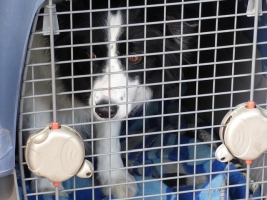PetFriendly.ca Home »
Pet Travel Tips »
Flying Safely
Flying Safely
By Race Foster, DVM, and Marty Smith, DVM
Drs. Foster & Smith, Inc.
 Airlines are required to report any incidents relative
to the transport of animals to the Department of Transportation.
Events to be reported include owner complaints and situations
in which an animal was lost, injured, or killed during transport.
Airlines are required to report any incidents relative
to the transport of animals to the Department of Transportation.
Events to be reported include owner complaints and situations
in which an animal was lost, injured, or killed during transport.
The Department of Transportation, in turn, will notify
consumers of such occurrences, contact the United States
Department of Agriculture, and work with the airlines to
improve employee training on the air transport of animals.
Passengers will also be informed under what conditions
their animals will be shipped.
According to the Air Transport Association, over 500,000
animals are shipped via the air every year. Approximately 1%
of the shipments encounter problems including transport in
unapproved kennels, missed flights, lost pets, and animals'
death.
Airline travel can be difficult for your pet. If it is
possible, you may want to consider having a dog sitter or
boarding facility take care of your dog while you are gone.
If you are going to take your pet, the following recommendations
will help you arrive safely at your destination.
- Obtain a health certificate from your veterinarian.
This health certificate should meet the requirements of your
state or nation of destination, as well as your airline carrier.
Be sure to check on the time restrictions. Certificates often
need to be obtained within 10 days of the flight.
- Carry the health certificate and your pet's
vaccination certificates with you.
- If taking an international flight, find out if your
pet will need to be quarantined at your destination.
This will influence your decision to take your pet.
- Limit the use of tranquilizers and sedatives. Only
use them on the recommendation of your veterinarian.
Tranquilizers and sedatives can affect the temperature
regulation of the body and cause other adverse effects.
- Reconsider flying with a brachiocephalic breed
(e.g., Pugs, Bulldogs, Boston Terriers), or other
animals who may have respiratory difficulties.
- Have your dog wear a collar, and attach a legible
and accurate identification tag with complete
information, the rabies vaccination tag, and a license
tag. Also include a tag with a friend's address and
phone number, since you will not be home to take any
messages.
- Place complete identification on the outside and
inside the crate.
- Use a portable kennel that meets with the USDA
and airline requirements.
- Clip your pet's nails. This will prevent breakage
of a nail if the pet scratches at the crate door.
- Attach a food dish and a water dish to the inside
of the crate. Position them so they can be filled
without opening the crate. You may want to freeze
water in the water dish ahead of time so it will
not spill during loading.
- Attach a container or ziplock bag of food to the
outside of the crate. You may securely attach a bottle
of water, as well.
- Give pets food and water about four hours before
departure.
- Bring along extra food and a leash in case your
flight is delayed.
- Be sure your pet is crate trained. For several
weeks before the flight get your pet used to spending
several hours in the crate with a comfortable pad and
toys. Feed your pet inside the crate so your pet
associates the crate with good things.
- Help your pet become accustomed to loud and
unfamiliar noises. You may even wish to take your
pet to the airport and spend some time outside
there. This will help your pet become familiar
with the sights and sounds.
- Make sure the crate door fastens securely, but
do not use a lock on the door. You want to be sure
the airline personnel can get to your pet rapidly
if it becomes necessary.
- Print 'Live Animal' on the top and sides of the
crate.
- Pack a first aid kit for your pet. It's always
a good idea to have one handy, just in case.
- When booking your flight, notify the airlines you
will be traveling with your pet. Obtain the airlines
policies and requirements for traveling with your pet.
Two weeks before your flight, recheck with your
airline again to be sure you can meet all the
requirements.
- Book on direct, non-stop flights. In the summer
avoid trips during the middle of the day.
- Travel on the same flight as your pet. If there
is a prolonged delay, you will be able to walk and
feed your pet, and if necessary take the pet to a
hotel with you.
- Provide plenty of exercise prior to your departure.
- After boarding, ask your flight attendant to notify
the pilot that you are flying with your pet.
- If your flight is delayed, ask the airline personnel
to offload your pet but not allow the pet to remain
unprotected from the weather on the tarmac.
© 2005 Drs. Foster and Smith, Inc.
Reprinted as a courtesy and with permission from
PetEducation.com.
On-line store at
DrsFosterSmith.com.
Free pet supply catalog: 1-800-323-4208
 Airlines are required to report any incidents relative
to the transport of animals to the Department of Transportation.
Events to be reported include owner complaints and situations
in which an animal was lost, injured, or killed during transport.
Airlines are required to report any incidents relative
to the transport of animals to the Department of Transportation.
Events to be reported include owner complaints and situations
in which an animal was lost, injured, or killed during transport.